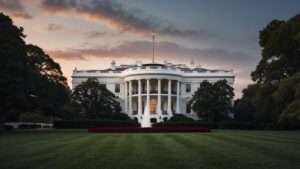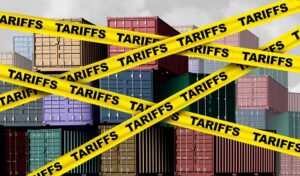20 Risks and Trends for 2025
AI and Jobs. Resource Nationalism. Managed Trade. Quantum Computing. GreenTech. Commercialization of Space. On January 15, WITA hosted noted futurist Robert Moran of Brunswick Group to discuss 20 notable global trends and risks for 2025.
Featured Speakers:
Robert Moran, Partner, Brunswick Group
Moderator: John Miller, Chief Economic Analyst, Trade Data Monitor
|
|
|
The Return of the Trump Tariffs – Navigating the Challenges of Trump’s Return to the White House
|
President-elect Trump will return to the White House…on 20 January 2025. He has already announced far-reaching policy changes, particularly in the area of international trade. He plans to impose a wide range of cross-sector tariffs with a particular focus on Chinese goods, but also targeting global imports with “universal tariffs”. This will put further pressure on globally operating business actors that are already dealing with U.S. tariffs, largely maintained under the Biden administration, coupled with a worldwide trend of protectionist trade measures. The next “episode” of the Trump Tariffs saga is likely to affect various businesses, with some critical sectors such as steel, aluminium and automotive facing particular challenges. In general, the trade agenda pursued by Donald Trump will represent another step back from the principles of barrierless, cooperative and predictable global trade. Globally operating businesses will need to prepare for further cost increases and supply chain disruptions. Key takeaways
What measures are planned and who will likely be most affected? Donald Trump’s tariff agenda during his second term will most likely build on the measures implemented during his first term and, to a large extent, maintained under the Biden administration. Recap: Trump Tariffs Episode I During Donald Trump’s first term tariffs have already been a central element of his trade policy. The introduction of tariffs was presented as a retaliation measure against unfair trade tactics and a way to boost the domestic economy and to reduce the U.S. trade deficit. Also, President Trump saw tariffs as a viable method of exerting pressure on competitors or influencing the policies of other countries. To achieve this aim, the Trump administration has imposed a series of tariffs on imports of solar panels, washing machines (30-50%), steel (25%) and aluminium (10%) from various countries (including the EU), as well as on most goods from China (affecting more than USD 380 billion worth of trade at the time). The Biden administration has maintained most of the measures against China but has lifted or eased certain tariffs on imports from other countries. For example, it replaced tariffs on steel and aluminium with tariff-rate quotas on imports from the EU, the UK and Japan. With regards to China, however, the Biden administration even imposed additional tariffs on Chinese goods, especially for electric vehicles (“EVs”) (100%), batteries (25%) and semiconductors (50%). In summary, while the situation has eased for some regions and sectors under the Biden administration, operators with global businesses and supply chains are still experiencing adverse effects, especially due to the existing high U.S. tariffs on Chinese imports. The situation could deteriorate further with an escalation under a second Trump administration. |
|
01/08/2025 | Ashurst |
Tariffs and Economic Isolationism:
Four Principles for a Response
|
|
01/15/2025 | Ed Gresser | Progressive Policy Institute |
Towards a UK Trade Strategy
The UK is facing a precarious and volatile period for global trade. The volume of global goods flows is back on the rise after a difficult 2023 caused by inflation and interest rate hikes. But with the return of President Trump to the White House, the outlook is deeply uncertain. Trade tensions are expected to escalate in the coming years, as economies become increasingly concerned over the risks of supply chain disruption. There has already been significant fragmentation in trade flows: the number of trade restrictions in 2022 was nearly 3,000, compared to under 300 a decade earlier, and from 2018 there has been a ‘decoupling’ of supply chains between the US and China.
The picture for UK trade has been lacklustre in recent years. The UK exercised its post-Brexit independent trade policy to rack up a series of roll-over deals and new trade agreements with countries such as Australia and New Zealand. But the new free trade agreements (FTAs) the government has negotiated have offered limited economic benefits, while larger deals with the US and India have proved elusive. At the same time, the change to the UK-EU relationship has reduced goods trade flows in both directions. The government’s approach has translated into a disappointing picture for goods trade with both the EU and the rest of the world: by the end of 2023, there was a 10 per cent fall in UK goods trade from 2019 levels, compared with an average 5 per cent rise for other G7 countries by the third quarter of 2023. However, services trade has performed much better: trade in services increased by 12 per cent by the end of 2023 compared to 2019 levels and the UK ranks only behind the US as the world’s largest services exporter.
The Department for Business and Trade is planning a new UK trade strategy. The trade strategy is integral to the government’s growth mission and complementary to its proposed industrial strategy, which intends to develop a proactive approach to driving forward economic growth. This is an important opportunity to revitalise the government’s approach to trade and adapt it to respond to the current geopolitical context.
The focus of the government’s trade strategy should be green, inclusive growth, while meeting the UK’s geopolitical objectives and securing economic resilience for critical sectors. Trade policy should be directed towards growth for all the UK’s regions and nations; growth which benefits living standards and working conditions; and growth which supports the green transition. At the same time, this must be delivered within a framework of economic resilience: that is, for certain industries critical for our economic and national security – including energy, defence, food, communications, and healthcare and pharmaceuticals – the government should take a proactive approach to safeguard supply chains against the risk of future disruption. At a time of growing global instability, trade policy must also align with the government’s agenda on foreign relations, security, migration, climate, development, and other geopolitical priorities.
|
WITA – We put the community in trade community.Information about upcoming WITA and trade community events TRADE COMMUNITY EVENTS CALENDAR |






